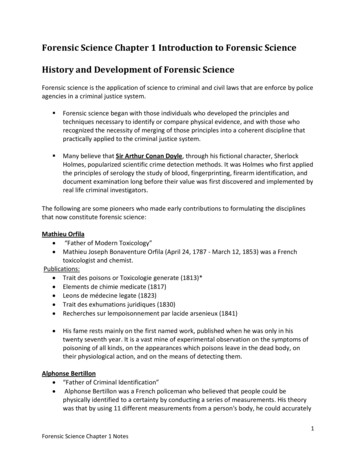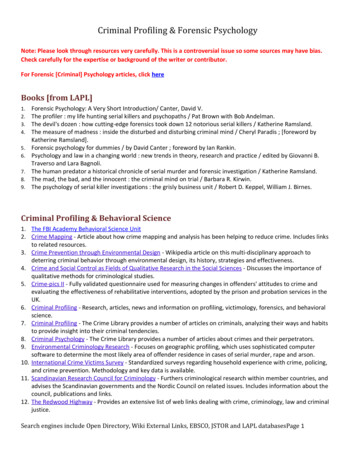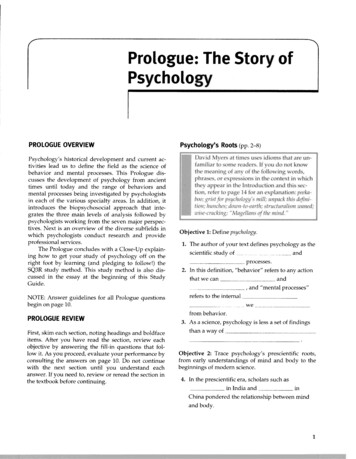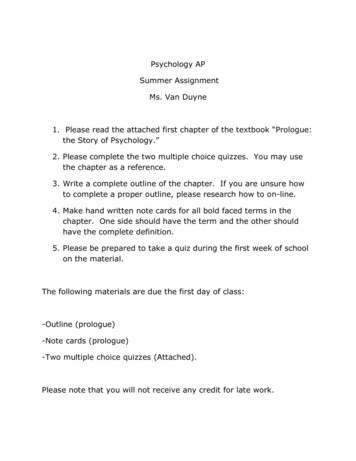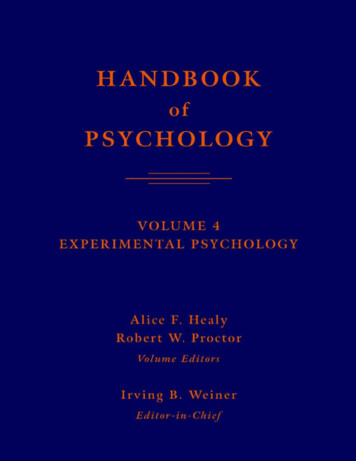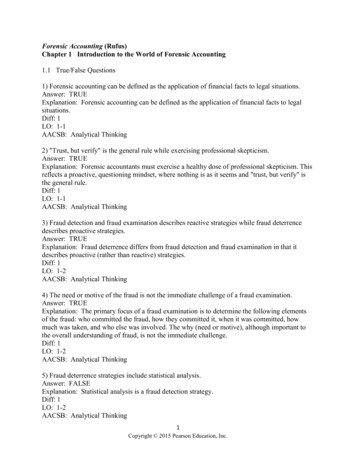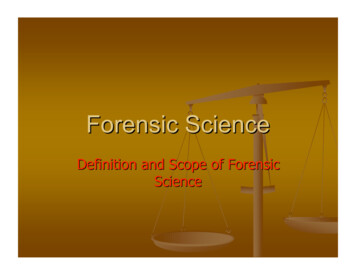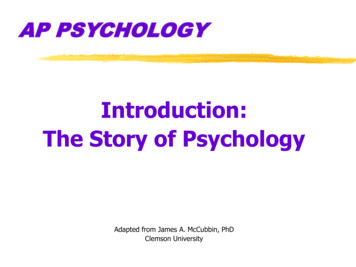
Transcription
Introduction toForensic Psychology
We have culture that is obsessed withcriminals and those who catch them:
Serial murder Films o. of films2334122023643
Serial murder Films 101990s0No. US Films
Serial Killers & Profiling: culture? TalkShows Films TV Show Plots Art Exhibits Comic Books TradingCards Pop Songs T-Shirts 900 Numbers ‘Cult’ groupies
Common Terms Modus Operandi – the operating technique used by theoffender. The actions necessary to commit murder.Signature – The signature is often referred to as the“calling card” of the offender. The person goes beyondwhat is necessary to commit the crime, i.e. stab a specificnumber of times.Staging – Altering the crime scene to throw theinvestigation, this may happen with organised offenders.Undoing – Undoing usually takes place when there is aclose relationship between the victim and offender.Concept of Escalation - The concept of escalationinvolves an increase in the intensity of criminal behaviour.Crimes start at a minor level and progress to worseninglevels. Burglary is often correlated with murder.6
Investigative Psychology DEFINITION:The application ofpsychology to criminal investigation. Profiling—oneof the tasks oftenassociated with investigativepsychology—requires sketching thesignificant psychological anddemographic features of a person orpersons.
Investigative Psychology Broadly defined, investigative psychologyincludes research and practice involving: Profiling Risk Assessment Police Line-ups Interrogation Polygraph Hypnosis
3 Questions asked by Profilers What are the important behavioral features of thecrime that may help identify and successfullyprosecute the perpetrator? What inferences can be made about thecharacteristics of the offender that may helpidentify him or her? Are there any other crimes that are likely to havebeen committed by the same person?
CRIMINAL PROFILINGBackground
What is Criminal Profiling? Criminal profiling is theprocess of identifyingpersonality traits,behavioral tendencies,geographical location,and demographic orbiographical descriptorsof an offender (oroffenders) based oncrime scenecharacteristics.
Goals of ProfilingThe primary goal of profiling is to narrow thefield of possible suspects. Profiling is also a form of prediction -- theprofiler tries to “predict” who the offender oroffenders might be and where and how thenext crime may occur.
Why Use Criminal Profiles inLaw Enforcement?Traditional investigative techniques oftenfall short in extreme cases. A subset of offenses/offenders areconsidered most suitable for profiling -
What crimes are more suitable for profiling? Suggested Crimes for ProfilingSadistic sexual assaultsSexual homicidePostmortem cases of abuse and humiliationMotiveless fire settingsLust and mutilation murdersRapeOccult and ritualistic crimesChild sexual abuse including pedophiliaBank robberiesAnonymous obscene communications
First Profile?: ‘Jack the Ripper’ First known case of killerprofiling-Dr. ThomasBond examined thevictim-Mary Kelly.Determined somepersonality traits of thekiller from victim.Often considered the firstrecorded serial killerbecause of the nature ofthe crimes (a typicalsexual motive).
Brief History of Criminal Profiling 1942 - First welldocumented use bypsychiatrist WalterLanger, a psychiatrist,was commissioned duringWWII to construct apsychodynamic profile ofHitler. His profilediagnosed Hilter’s mentalstate and correctlypredicted what wouldhappen were he to bedefeated – i.e. suicide.
1957 – NYC’s Mad Bomber. Psychiatrist James Brussels workedwith NYPD to construct a profile.George P. Metesky, terrorizedNYC for 16 years (1940s - 50s)with explosives planted in theaters,terminals, libraries, phone booths,storage lockers and offices. Bombswere left in public buildings.Perhaps most notably, Meteskybombed movie theaters, where hecut into seat upholstery andslipped his explosive devicesinside.
Does not always get it right – Example:The Boston Strangler Profiled as “twomale schoolteachersliving alone, one ofwhom was probablyhomosexual”Reality: AlbertDeSalvo –heterosexualconstruction workerliving with his family
1970s-1980s - FBI became involved inpsychological profiling and popularizedthe technique. 1990s – 2003 - attempt to “scientize”profiling and move the practice beyondthe purview of the FBI.
The FBI ProfilersSmall/prominent group of FBI profilers helpedto popularize the term in 1970s in theBehavioral Science Unit -- called the NationalCenter for the Analysis of Violent Crime(NCAVC) since 1984. Responsible for establishing the ViolentCriminal Apprehension Program (VICAP).Published Crime Classification Manual, SexualHomicide: Patterns and Motives and truecrime novels. Criticized for relying too much onintuition/faulty use of the scientific method.
Is Profiling a Science or Profession? Profiling has not yet achieved the status of aprofession. Factors hindering professionalization: Lack of consensus (on terms, approaches, training,appropriate experience/educational background,etc.). Practical issues (sensitivity and confidentiality ofcases). Ego/territorial issues. Absence of uniform standards, practices, peerreview, and ethics. Small number (if any) of profiling positions whereprofiling is the primary job description. The notion (and acknowledgement among manyprofilers) that profiling is more art than science.
Assumptions Made (About a singlesubject) in the Profiling Process: Crime scene reflects the personality ofthe offender. M.O. remains similar. Signature will remain the same. Offender’s personality will not change.
The Organized-Disorganized Typology Whether or not the crime scene is left ORGANIZEDor DISORGANIZED is said to provide informationabout the offender’s criminal sophistication andpersonality.Organized crime scene reflects offender whocommits crime out of a need for power. Motivationassociated with PSYCHOPATHY.Disorganized crime scene reflects offender whocommits crime out of passion, compulsion,frustration, or anxiety. Motivation associated withPSYCHOSIS.
The Organized Crime Scene Offense plannedVictim a targetedstrangerVictim personalizedControlled conversationCrime scene reflectsoverall controlDemands submissivevictim Restraints usedAggressive acts prior todeathBody hiddenWeapon/evidenceabsentvictim or bodytransported from sceneAssociated withpsychopathy
The Disorganized Crime Scene Spontaneous offenseVictim or locationknownDepersonalizes victimMinimal conversationCrime scene randomand sloppySudden violence tovictim Minimal use ofrestraintsSexual acts after deathBody left in viewEvidence/weapon oftenpresentBody left at deathsceneAssociated withPsychosis
Interview/Interrogation Strategies ORGANIZED Direct confrontationRespects competencyOne-person interviewDon’t expect “freeinformation”No use of “false evidence”(are too sharp for this)Conduct when suspect hasno time to gatherthoughts DISORGANIZED Relationship motivatedEmpathyConstant stream ofconversationUse positive personalrelationshipConduct at night
FBI Psychological Profile of Lust KillersOrganised Killer intelligent high birth order masculine image charismatic socially capable sexually capable occupationally mobile lives with partner geographically mobile experienced harsh childhood discipline controlled emotions interested in media model inmateDis-organised Killer below average IQ low birth order socially immature seldom dates high school failure unemployed father lives alone has secret hiding places nocturnal lives/works near crime unskilled worker behaviour change low interest in media little alcohol consumption high anxiety during crime27
Organized Killers:BTK Jeffery Dahmer Dexter Ted Bundy
Disorganized Killers: Ed Gein “Son of Sam”David Berkowitz
Classification of OffendersORGANISEDDISORGANISEDVICTIMSWives and girlfriends safe –gets more pleasure fromkilling than sex with wivesand girlfriends – SingleWhite Female.Anybody – very poorrelations with women ingeneral. Usually live alone.CRIME SCENECrime scene staged, andtransport bodyNo staging, leave bodywhere killed.WEAPONMay carry weapon with him,and take them away after thecrime, i.e. rape kitsUses weapon ofopportunity, frenzied attack,often depersonalizes thevictim, i.e. turn them ontheir stomachs30
Classification of r at school.Classmates won’tremember the offender.PERSONALITYExternalize anger, oftenattractive, confident,intelligent, good verbalskills. History ofproblems with authority.Internalize anger,physically unattractive,low self-esteem, andprevious suicide attempts,not very articulate inconversation.RELATIONSHIPS WITHWOMENTalks to women, mood isfairly controlled.Doesn’t often talk towomen, mood is anxious31
Classification of OffendersORGANISEDDISORGANISEDPLACE OFRESIDENCELive some distance from thecrime, except the first crime,as it is close to home and morecomfortable. Usually livewith a woman.Kills where there isfamiliarity, usually close tohome or to work. Livesalone.PRE-OFFENCEMay be precipitated by loss ofjob or break-up with partner.Low self-esteem comes onvictim of opportunity.PUBLICITYTakes interest in media reportsof crime, will often try to getinvolved with the policeinvestigationNo interest in / fear of mediareports of crime.32
Distinction BetweenPsychopathy and Psychosis PSYCHOPATHY Personality disorder made up of a particularconstellation of characteristics).Lack of attachment, defect in affect, absence of anxiety.In touch with reality. Severe Lack or Empathy. PSYCHOSIS Clinical mental illness – Schizophrenia.May meet legal definition of insanity.Out of touch with reality.
Criticism of the Organized/Disorganized Typology Developed/oversimplified for use by lawenforcement professionals with little academictraining in criminology, psychology, and forensicscience and encourages unsophisticatedprofiling.Is a FALSE DICHOTOMY --few offenders/crimescenes fit neatly into either type. Hillside Stranglers, Bianchiand Buono.Zodiac Killer
M.O. and Signature METHOD OF OPERATION (M.O. – Modus Operandi) How the offender committed the crime. Tells about theexperience of the offender and situational/contextual factorsinvolved in the crime.SIGNATURE The behavior/expression of fantasy the killer must leave atthe scene to satisfy emotional/psychological needs. Goesbeyond what’s necessary to commit crime and tells about theoffender’s psychological needs and motivation. ZodiacBTK
Factors that Shape M.O. Trade/Professional Experience Criminal experience and confidence Contact with the criminal justice system Media and pop culture Offender Mood/Mental state X-Factors (unknown/unplanned influences)
Factors that Shape Signature Personality/Psychopathology Evolution of Fantasy Zodiac operated under theassumption that he was toosmart to be caught – I guesshe was right.Zodiac’s fantasy evolved as hetaunted police.
Distinguishing M.O. from Signature Signature and M.O. needs may be satisfiedby the same behavior. Important toremember the “two most important axiomsof criminal profiling”: Different offenders do similar things fordifferent reasons. Offender behaviors can be the result ofmultiple motivations and/or externalinfluences.
Static and Dynamic Risk Offender risk factors are static and dynamic. Areimportant in understanding M.O. and Signaturebehaviors. STATIC RISKs: Stay the same over time. Possibility of getting caught during a rape orrobbery. DYNAMIC RISKs: Change over time. Stable dynamic: change slowly over monthsor years. Acute dynamic: change rapidly over minutesor days. Changing of police patrols. Possible victims being more aware or theirdanger.
Geographical Profiling and Mapping Geographical profiling refersto the analysis of geographicallocations associated with thespatial movements of a singleserial offender, Geographical mapping isconcerned with analyzing thespatial patterns of crimescommitted by numerousoffenders over a period of time.Geographical mapping focuseson identifying the “hot spots” ofcertain types of crime.
The Polygraph The polygraph—commonly called the “lie detector”—detectspsychophysiological responses that accompany emotionalreactions to guilt, shame, and anxiety through heart rate, bloodpressure, breathing rate, and skin conductance. In addition to observing the physiological measures, the skillfulpolygrapher makes behavioral observations and notations to infertruth or deception in the subject being examined. The polygraph can accurately measure and record thephysiological responses but it is unclear whether it can detectactual lying and deception.
This movie isn’t exactly how it works
Current Approaches to Offender Profiling:American Approach:Incarcerated serialmurderers (36)interviewed. Categorised into organisedor disorganised. View crime scene forindicators.
Current Approaches - American Basis of FBI Approach is: Crime scene and MO as indicators of individualpathology.Compare with known offenders.May fit pattern.Can be used to detect, but also to predict andtherefore prevent.
Current Approaches - American Aims of American profiling approach are: Reduce scope of investigation.Allow some prediction of future offences.Provide a psychological evaluation ofbelongings found in the murderers possession,e.g. souvenirs from previous offences.Provide strategies for interviewing.
Current Approaches - American Known as “holistic” or “top-down”approach. Data from scene and from MO comparedwith previously known information. Mainly with murderers in USA, not sooften with lesser crimes.
Current Approaches - BritishBritish approach is less subjective. Cal
What is Criminal Profiling? Criminal profiling is the process of identifying personality traits, behavioral tendencies, geographical location, and demographic or biographical descriptors of an offender (or offenders) based on crime scene characteristics.
